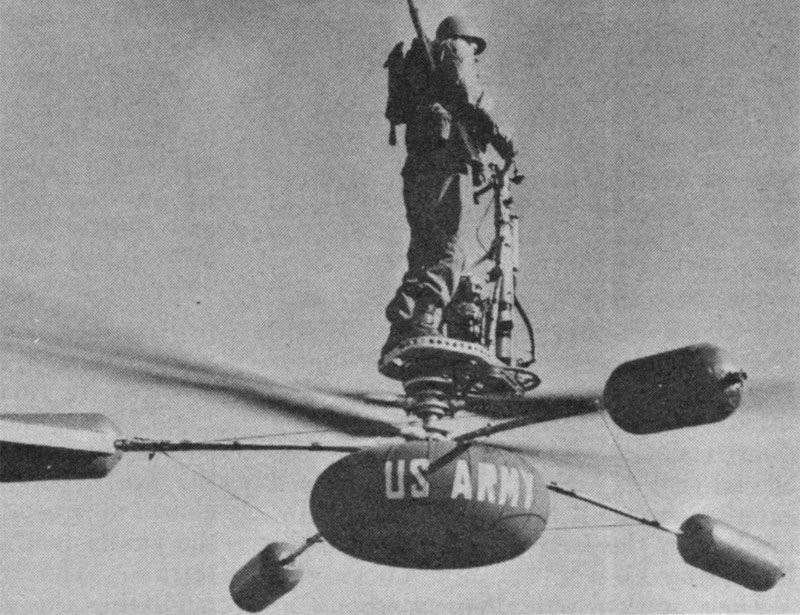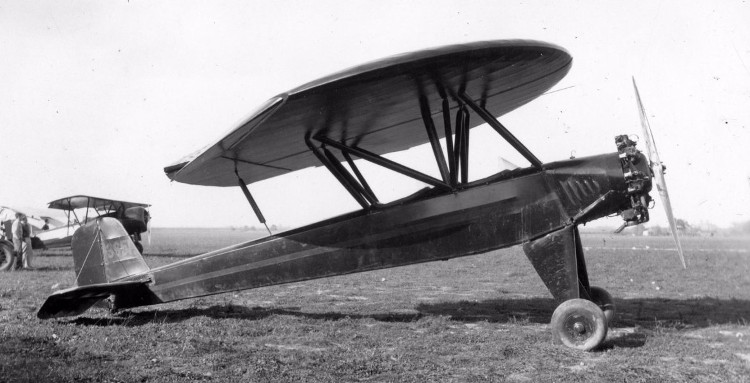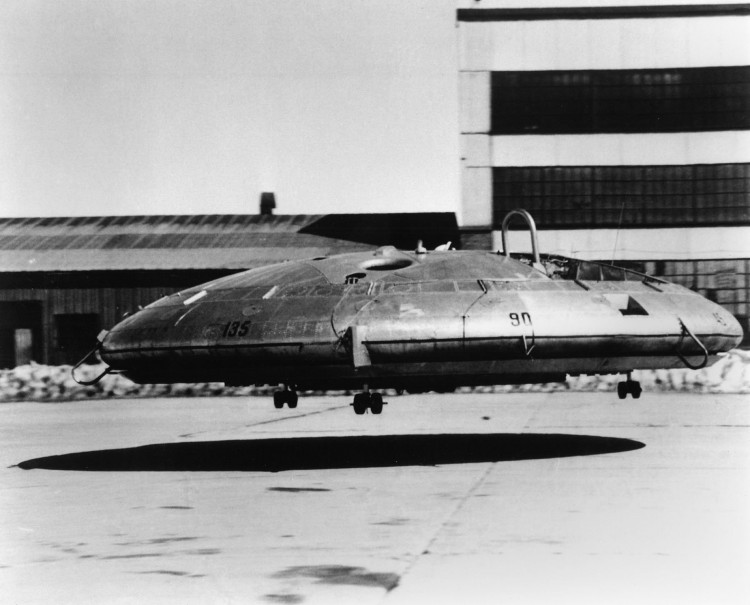11 kinds of bizarre planes ever appeared on Earth
Aviation history has witnessed many times "change and change shape" of aircraft, from the appearance of flying saucers to hollow tubes. Of course, not all improvements are successful, but they are a testament to the continuous innovation efforts of engineers and design professionals over the years.
Here are some of the most bizarre aircraft that ever appeared on Earth:
De Lackner Aerocycle

Aerocycle is designed to fly as high as 112.6 km / h and only takes 20 minutes to guide a soldier to use it.
The US military invented a type of flight platform called Aerocycle and tested it for the first time at Brooklyn military airport in 1955. It was designed to fly as high as 112.6 km / h and only need 20 minutes. instructions for a soldier to use it. However, the system proved too prone to accidents during the first test flights, so the US authorities abandoned the project to develop it.
Nemeth Parasol

The Nemeth model has never been mass produced.
Students at the University of Miami (USA) have built a prototype of a bizarre shape, designed by inventor Steven Nemeth, to prove that a circular wing can help aircraft fly effectively. The round wing also plays a role even if the engine dies, allowing the plane to float slowly to the ground. Despite the successful test flight in 1934, the Nemeth model has never been mass produced.
Avro Canada VZ-9 Avrocar

Avro Canada VZ-9 Avrocar looks like a flying saucer or spaceship in a science fiction series.
At first glance, Avro Canada VZ-9 Avrocar looks like a flying saucer or spaceship in the "Star Wars" sci-fi series , but it is a model developed by the Canadian government at the beginning of the in 1950. To take off vertically from the ground, two jet turbines drove the force downwards, creating an air cushion. The Army and the US Air Force took over the project in 1958 and developed two Avrocar prototypes. However, this type of aircraft proved unstable in aerodynamic tests. The project was canceled in 1961 and currently has two prototypes of aircraft being kept in the Army Transport Museum and the US National Air Force Museum.
Caproni Ca.60 Noviplano

Caproni Ca.60 Noviplano owns 9 wings and 8 engines, 3 stories high and can accommodate 100 passengers.
As the "biological child" of Italian aircraft design expert Gianni Caproni, Caproni Ca.60 Noviplano is expected to become a flying boat. It owns 9 wings and 8 engines, 3 stories high and can accommodate 100 passengers. If you think it looks unstable, you're absolutely right. The plane crashed on the first test flight of 1921. The pilot survived, but all necessary repairs to the prototype proved to be too expensive.
Vought V-173

Chance Vought built and drove Vought V-173, but no other version was born.
Nicknamed "flying sweet cake" , this flat, round model designed by Charles Zimmerman is designed to mobilize easily from tanks and warships during World War II as well as to counteract the attacks of Japan. Chance Vought built and drove Vought V-173, but no other version was born. The US Navy gave it to the US National Aeronautics and Space Museum in 1960. During a visit in 2002, a manager of Vought aerospace company found the model still recoverable. OK. Thus, a group of Vought retired employees gathered and shook hands to restore it for eight years, until it was officially released again in 2012.
Northrop XB-35

The Northrop XB-35 bomber was developed by aircraft designer Jack Northrop.
During World War II, the US Air Force announced that it wanted to buy an aircraft that could fly more than 16,000km and transport about 4,536kg of goods (mostly bombs). The Northrop XB-35 bomber was developed by aircraft designer Jack Northrop, Northrop's founder, but problems with the propeller made it unstable. The war ended before the development project was completed and the program was canceled in 1950.
McDonnell XF-85 Goblin

This is the smallest jet fighter model ever built.
The smallest jet fighter model ever built, the McDonnell XF-85 Goblin is designed to fasten onto a bomber and protect the host aircraft in case of attack. Goblin flies well, but is not equipped with self-landing structure, so it must be re-attached to the host plane. The pilots had trouble re-connecting Goblin with bombers, so the test program was canceled in 1949.
The Aero Spacelines B377PG Pregnant Guppy

This giant aircraft was first tested in 1962.
Built to transport "tremendous" goods to the US Aerospace Agency's Apollo program, this giant aircraft was first tested in 1962. It was primarily used to transport parts of Saturn 5 missiles to Cape Canaveral. Its later versions are called Super Guppy and Super Guppy Turbine . They have been used to transport components of the International Space Station (ISS) from manufacturers across the globe.
Rutan Boomerang

This special model can travel up to 489km / h.
Aviation engineer Burt Rutan designed Rutan Boomerang in 1996 as a high-performance aircraft and could be easily controlled if an engine is broken. Asymmetry makes Rutan Boomerang different from other two-engine aircraft as well as safer when it comes to technical problems. This special model can travel up to 489km / h.
Proteus

Proteus is also designed by Burt Rutan.
Like Boomerang, Proteus is also designed by Burt Rutan. It was created to act as a telecommunications relay system, carrying an antenna system for broadband data relay. The first test flights began in 1998 and in 2000, Proteus set up 3 flight altitudes, with a peak of over 19.2 km.
Hybrid airship Lockheed Martin

Lockheed Martin's P-791 was released in 2006.
Lockheed Martin's P-791 was released in 2006 to demonstrate its hybrid airship technology. Helium-filled balloons are designed to be vehicles for transporting goods to remote locations. They can limit their wings on the ground or on water and only consume one tenth of the energy per ton compared to helicopters. Lockheed Martin won the first production contract for the P-791 for Straightline Aviation, worth about $ 480 million in March.
- Revealing the top secret stealth aircraft of America
- 10 weirdest aircraft in the world
- When the real bird throws down, the iron bird
- Discover a series of bizarre creatures in the deepest abyss of Earth
- 8 incredible bizarre animals exist in the world
- Exotic monstrous monsters with many ngoe nguoi tentacles appeared at the coast of Australia
- Video: The scene of two people flying next to Airbus A380 is unbelievably impressive
- 'Glimpse' strange monsters exist on Earth
- The first dinosaurs appeared on Earth
- Video: Whirlwind in Latvia
- Planes around the world
- Marvel at the horned banana tree in Gia Lai
 'Fine laughs' - Scary and painful torture in ancient times
'Fine laughs' - Scary and painful torture in ancient times The sequence of numbers 142857 of the Egyptian pyramids is known as the strangest number in the world - Why?
The sequence of numbers 142857 of the Egyptian pyramids is known as the strangest number in the world - Why? History of the iron
History of the iron What is alum?
What is alum?